Books
Ancient Egypt Research Associates’ Object Typology
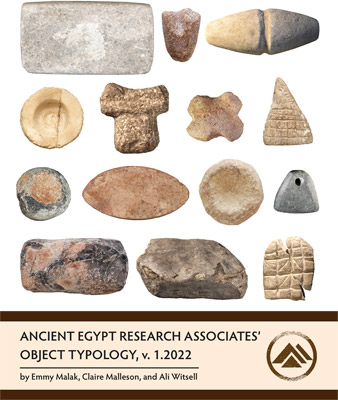
The AERA Object Typology is a richly illustrated introduction to the everyday objects of the pyramid workers. It is the result of work by a large team of specialists over more than 30 years.
We selected images and descriptions of representative objects for this book from AERA’s massive collection of finds from the Giza plateau. Each object class is illustrated with numerous photographs and drawings and introduced with Old Kingdom tomb scenes showing its general use.
AERA started working on the Giza plateau in 1988. We conduct our excavations using careful stratigraphic methods, detailed recording, and painstaking recovery of as much material culture as possible. As a result, the archaeological record we’ve produced is almost unparalleled in Egypt. Over the past 35 years, our team has recovered literally millions of artefacts. Many of these fall within “bulk finds” categories (ceramics, animal bones, etc.), but items that occur less frequently—such as axes, hammers, stone vessels, personal adornments, gaming/accounting pieces and tools used for weaving, fishing, grinding or drilling—are dealt with separately. AERA has recovered several thousand of these objects, which represent the toolkits for Old Kingdom pyramid construction. Even when small or incomplete, these finds reveal a great deal about the daily lives of the ancient Egyptians.
This is not a catalog, so does not contain all objects found by AERA. Instead, it is a living typology document, providing examples of the different kinds of artifacts found during our excavations. As our field and lab work continues, we will update this book with new examples as they are discovered. Future editions will also include examples of Late Period burial items and dedicated sections on copper object types and statue fragments. Our ultimate goal is to publish an online catalog of the 4800+ objects recovered during AERA’s excavations at Giza.
We hope this book is a useful tool for archaeologists working in other Egyptian (Old Kingdom) settlement sites, helping facilitate comparisons between their assemblages and ours, and to students of Egyptian Archaeology around the world, enabling us all to develop more sophisticated lines of inquiry and investigation into the “everyday” material culture of ancient Egypt.
This publication was made possible due to a generous Antiquities Endowment Fund data conservation from the American Center of Research in Egypt (ARCE) and to the support of AERA members. We are deeply grateful for their support!
The Red Sea Scrolls: How Ancient Papyri Reveal the Secrets of the Pyramids
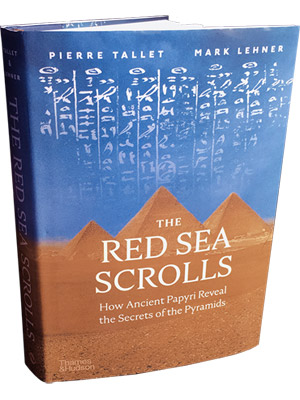 The inside story, told by excavators of the extraordinary discovery of the world’s oldest papyri, revealing how Egyptian King Khufu’s men built the Great Pyramid at Giza.
The inside story, told by excavators of the extraordinary discovery of the world’s oldest papyri, revealing how Egyptian King Khufu’s men built the Great Pyramid at Giza.
Pierre Tallet’s discovery of the Red Sea Scrolls—the world’s oldest surviving written documents—in 2013 was one of the most remarkable moments in the history of Egyptology. These papyri, written some 4,600 years ago, and combined with Mark Lehner’s research, changed what we thought we knew about the building of the Great Pyramid at Giza.
Here, for the first time, the world-renowned Egyptologists Tallet and Lehner give us the definitive account of this astounding discovery. The story begins with Tallet’s hunt for hieroglyphic rock inscriptions in the Sinai Peninsula and leads up to the discovery of the papyri, the diary of Inspector Merer, who oversaw workers in the reign of Pharaoh Khufu in Wadi el-Jarf, the site of an ancient harbor on the Red Sea. The translation of the papyri reveals how the stones of the Great Pyramid ended up in Giza. Combined with Lehner’s excavations of the harbor at the pyramid construction site the Red Sea Papyri have greatly advanced our understanding of how the ancient Egyptians were able to build monuments that survive to this day.
Tallet and Lehner narrate this thrilling discovery and explore how the building of the pyramids helped create a unified state, propelling Egyptian civilization forward. This lavishly illustrated book captures the excitement and significance of these seminal findings, conveying above all how astonishing it is to discover a contemporary eyewitness testimony to the creation of the only remaining Wonder of the Ancient World.
Pierre Tallet is a professor of Egyptology at the Sorbonne and president of the French Society of Egyptology. He is the leader of the archaeological mission at Wadi el-Jarf, where he discovered the Red Sea Papyri.
Mark Lehner is president of Ancient Egypt Research Associates and research associate at the Oriental Institute of the University of Chicago. He has conducted fieldwork at Giza for over forty years. He is the author of the bestselling The Complete Pyramids and the definitive volume on the subject, Giza and the Pyramids.
“This landmark, elegantly illustrated book is the first to reveal how the raw materials used in the Great Pyramid’s construction…were transported to Giza via Egyptian ports during the reigns of Sneferu and his son Khufu.” ―Science Magazine book review
Available now at Amazon or Bookshop.org
Giza and the Pyramids: The Definitive History
 Mark Lehner and Zahi Hawass provide insights into the history of the Giza plateau based on more than 40 years of excavating and studying the site. Though today the pyramids and the Sphinx rise from the desert, isolated and enigmatic, they were once surrounded by temples, vast cemeteries, harbors, and teeming towns. This book describes that past in vibrant detail, along with the history of exploration, the religious and social function of the pyramids, how the pyramids were built, and the story of Giza before and after the Old Kingdom. These monuments are brought to life through hundreds of illustrations, including photographs of the monuments, excavations, and objects, as well as plans, reconstructions, and images from remote-controlled cameras and laser scans.
Mark Lehner and Zahi Hawass provide insights into the history of the Giza plateau based on more than 40 years of excavating and studying the site. Though today the pyramids and the Sphinx rise from the desert, isolated and enigmatic, they were once surrounded by temples, vast cemeteries, harbors, and teeming towns. This book describes that past in vibrant detail, along with the history of exploration, the religious and social function of the pyramids, how the pyramids were built, and the story of Giza before and after the Old Kingdom. These monuments are brought to life through hundreds of illustrations, including photographs of the monuments, excavations, and objects, as well as plans, reconstructions, and images from remote-controlled cameras and laser scans.
“Lehner and Hawass have produced an astonishingly comprehensive study of the excavations and scientific investigations that have, over two centuries, uncovered the engineering techniques, religious and cultural significance and other aspects of the Giza site.” Read the full review in Nature.
Available now on Amazon or Bookshop.org.
Treasures from the Lost City of Memphis
 Treasures from the Lost City of Memphis is the first detailed catalog of the remarkable collection of artifacts from the Mît Rahîna museum. The museum sits on archaeological remains in the heart of the Memphite ruin field and displays a substantial and remarkable collection of monuments, including several unique pieces that deserve to be more widely known. With this book we hope to offer insight into the museum’s collection and context, as well as the history and excavation of Memphis, Egypt’s ancient capital city.
Treasures from the Lost City of Memphis is the first detailed catalog of the remarkable collection of artifacts from the Mît Rahîna museum. The museum sits on archaeological remains in the heart of the Memphite ruin field and displays a substantial and remarkable collection of monuments, including several unique pieces that deserve to be more widely known. With this book we hope to offer insight into the museum’s collection and context, as well as the history and excavation of Memphis, Egypt’s ancient capital city.
This important research work stems from our Memphis Development Project (MDP), a joint effort with the University of York, funded by a grant from the United States Agency for International Development (USAID) and AERA’s members and donors. In 2011 and 2014 we ran field schools at Memphis, the first major field archaeology projects there in 20 years. During this time, we saw first hand that Memphis urgently needed the world’s attention once again as modern development and neglect threatened this ancient capital, so important to Egyptian and world history. Responding to this urgent need, as part of the MDP we cleaned seven archaeological sites within Memphis and installed pathways between each. Our field school students also created documentation to make the site more accessible and understandable to visitors. We also renovated and enhanced the museum and as part of the documentation process and recorded and researched its collection.
The fruit of that work is Treasures from the Lost City of Memphis, the first volume to provide a comprehensive presentation of both the museum’s history and a catalog of its treasures, richly illustrated and researched, and presented against an informative backdrop of the excavation history of Memphis.
Treasures from the Lost City of Memphis, richly illustrated and researched by AERA archaeologist Aude Gräzer Ohara, is now freely available to students, scholars, and museum visitors from around the world.
Download a free PDF of Treasures from the Lost City of Memphis
A Manual of Egyptian Pottery, volumes 1-4
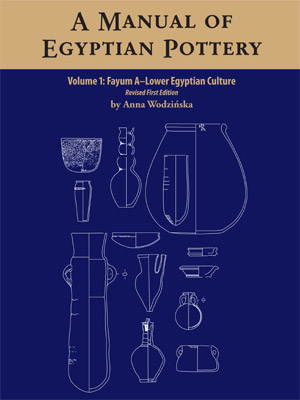 AERA has begun to publish its field school manuals with the four-volume A Manual of Egyptian Pottery by Dr. Anna Wodzinska. This four-book set covers Egyptian pottery, ranging from the earliest (Fayum A) ceramics to pottery made in Egypt today, organized by historical periods. The manuals are quick identification guides as well as starting points for more extensive research.
AERA has begun to publish its field school manuals with the four-volume A Manual of Egyptian Pottery by Dr. Anna Wodzinska. This four-book set covers Egyptian pottery, ranging from the earliest (Fayum A) ceramics to pottery made in Egypt today, organized by historical periods. The manuals are quick identification guides as well as starting points for more extensive research.
For each period, ceramic types are illustrated with a line drawing, accompanied by a description that includes information on the pot’s material, manufacturing techniques, surface treatment, and shape. Color plates of representative ceramic types are included to give the clearest sense of the color, composition, and surface treatment. All four volumes provide an extensive list of suggested readings as well as a bibliography for each period. Introductory chapters in each book discuss the basics of pottery manufacture and analysis. The first comprehensive guide to Egyptian pottery, this set will prove valuable to students as well as experienced field archaeologists. The volumes come in paperback and spiral-bound versions. The spiral bound versions, with hard laminated covers and tabs, are designed especially for the field and lab.
Download the free PDFs by selecting one of the volumes below or order printed copies from ISD.
A Manual of Egyptian Pottery Volume 1 Revised Edition: Fayum A–Lower Egyptian Culture
A Manual of Egyptian Pottery Volume 2 Revised Edition: Naqada III–Middle Kingdom
A Manual of Egyptian Pottery Volume 3: Second Intermediate Period–Late Period
A Manual of Egyptian Pottery Volume 4: Ptolemaic Period–Modern
Settlement and Cemetery at Giza
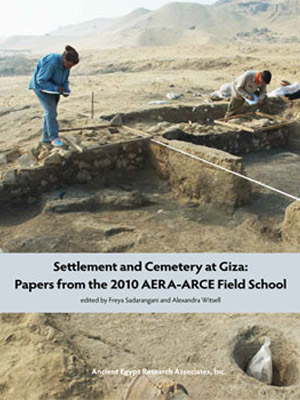 This volume is the first in a series of planned volumes representing the culmination of student work prepared during our Analysis and Publication Field Schools, the final step in our four-part field school for Ministry of Antiquities Inspectors run in conjunction with the American Center for Research.
This volume is the first in a series of planned volumes representing the culmination of student work prepared during our Analysis and Publication Field Schools, the final step in our four-part field school for Ministry of Antiquities Inspectors run in conjunction with the American Center for Research.
Settlement and Cemetery: Papers from the 2010 AERA-ARCE Field School presents preliminary excavation and specialist reports detailing fieldwork and material culture analysis from the Heit el-Ghurab (HeG) and Khentkawes Town (KKT) sites carried out during 2010 and 2013 field school seasons.
The book includes the following papers on the AA and EOG-D Bakeries, a report on the “pedestal” structures in MSE, a ceramics report, a report on faunal remains from the AA Bakery, an osteological study on Late Period burials, an archaeobotanical report, and a brief history of our field schools.
It is with great pride that we present this volume of our students’ work. In some cases, these papers are our students’ first print publication—a momentous achievement for any young scholar. Providing both training and a platform for publication helps our students become active participants in their country’s proud archaeological heritage, not only playing a role in safeguarding it but also in disseminating it to the world.
We are proud to present their work and feel strongly that it contributes towards a further understanding of Old Kingdom and Late Period Giza. Thank you to all our members for helping to make this rewarding endeavor possible.
Download a PDF of Settlement and Cemetery at Giza: Papers from the 2010 AERA-ARCE Field School
Find out more about our Field School Program.
Giza Reports
 While the builders of the Giza pyramids built amazing monuments for pharaohs Khufu, Khafre, and Menkaure, they also created one of the earliest examples of urban planning. When the last Giza pyramid was completed, the Lost City was abandoned and forgotten until its rediscovery within the past two decades.
While the builders of the Giza pyramids built amazing monuments for pharaohs Khufu, Khafre, and Menkaure, they also created one of the earliest examples of urban planning. When the last Giza pyramid was completed, the Lost City was abandoned and forgotten until its rediscovery within the past two decades.
Giza Reports details our work at the settlement of the pyramid builders. The volume is illustrated with 196 line drawings and 96 black and white photos. It also includes two large fold-out maps: a topographical map of the Giza Plateau and a map of the excavation site. 336p, 292 b/w illustrations and photos, maps. Contents include:
SURVEY: The Beginning, Giza Survey Notebook, GPMP Surveying and Mapping Control Datums
MAIN STREET: Excavations, Ceramics, Lithics, Plant Remains, Charcoal, Faunal Remains, Sealings
GALLERY III.4: Excavations, Ceramics, Lithics, Plant Remains, Charcoal, Faunal Remains, Sealings
CERAMICS: Preliminary Report on the Ceramics
The Complete Pyramids: Solving the Ancient Mysteries
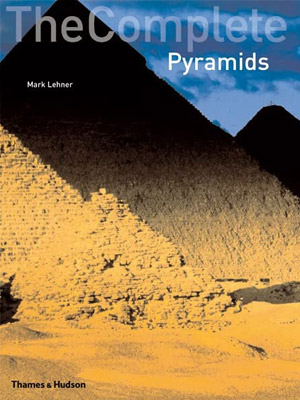 Mark Lehner brings his many years of field research in Egypt to this definitive book. He examines the pyramids in unprecedented detail, covering the practical aspects―the quarries, ramps, and tools used in construction―as well as the conceptual ones.
Mark Lehner brings his many years of field research in Egypt to this definitive book. He examines the pyramids in unprecedented detail, covering the practical aspects―the quarries, ramps, and tools used in construction―as well as the conceptual ones.
Professor Lehner surveys and describes the pyramids across their 3,000-year history, as well as explaining the rituals and mythology, the history of travelers, looters, and archaeologists, and the ways in which the pyramids were an integral part of the Egyptian state.
The hundreds of illustrations include computer reconstructions and specially commissioned artists’ perspective views of the pyramids and their interior chambers. 556 illustrations, 83 in color.
